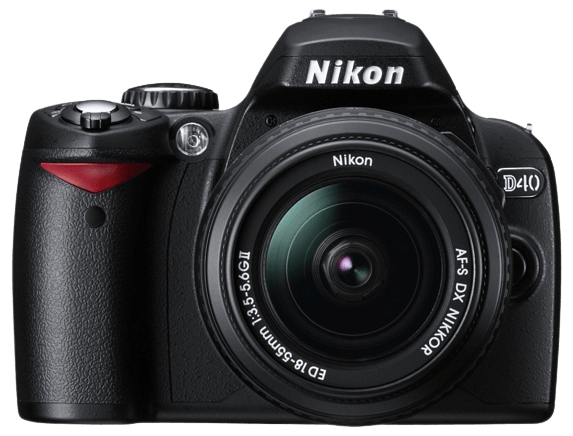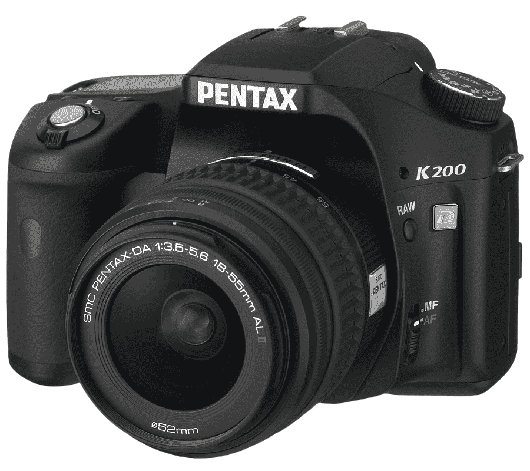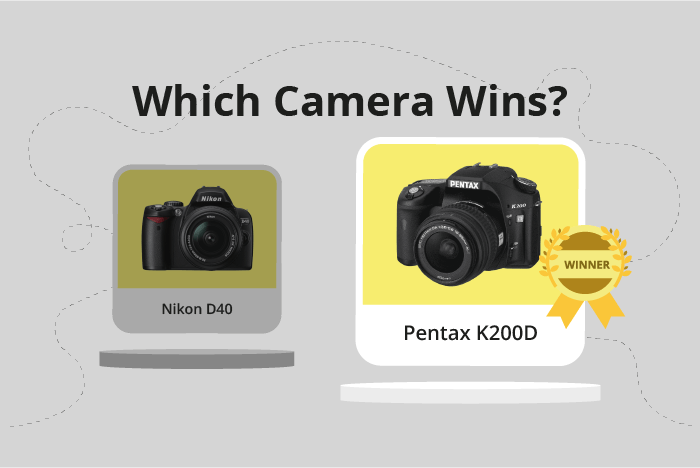Nikon D40 vs Pentax K200D Comparison
Nikon D40

Pentax K200D

The Pentax K200D outperforms the Nikon D40 with a score of 44/100 compared to the D40’s 28/100. Both cameras are DSLRs, launched in 2006 and 2008 respectively. They share similar dimensions, with the K200D measuring 134 x 95 x 74mm and the D40 at 124 x 94 x 64mm. However, the Pentax K200D is heavier at 690g, while the Nikon D40 weighs 522g.
The Pentax K200D’s higher score reflects its better overall performance and features. However, the Nikon D40 has its advantages, such as being lighter and more affordable, with a launch price of $400 compared to the K200D’s $660.
Considering the specifications, the Pentax K200D is the superior camera, but the Nikon D40 may be a better choice for those prioritizing a lighter and more budget-friendly option.
Nikon D40 vs Pentax K200D Overview and Optics
The Pentax K200D outperforms the Nikon D40 in optics with a score of 48/100 compared to the D40’s 33/100. Both cameras share some common specifications, such as having a CCD sensor type, APS-C sensor size, and a similar shooting speed (2.8 for the K200D and 2.5 for the D40). However, the K200D has several advantages that contribute to its higher score.
The Pentax K200D has 10.2 megapixels, while the Nikon D40 has only 6 megapixels. This difference allows the K200D to capture more detail in images. Additionally, the K200D has a higher DXOMARK score for its sensor at 64, compared to the D40’s score of 56. This indicates better overall image quality from the K200D’s sensor. The K200D also features image stabilization, which the D40 lacks, making it more effective at reducing camera shake and producing sharper images. The K200D uses the Pentax KAF lens mount, providing access to a wide range of lenses.
The Nikon D40, however, has some advantages as well. It uses the Nikon F DX lens mount, which is compatible with a vast selection of high-quality lenses. Furthermore, the D40’s image processing engine is developed by Nikon, a reputable and well-known brand in the photography industry.
Taking these factors into account, the Pentax K200D is the superior camera in terms of optics, thanks to its higher megapixel count, better sensor performance, and image stabilization. The Nikon D40 remains a viable option, primarily due to its compatibility with the extensive range of Nikon F DX lenses.
Nikon D40 vs Pentax K200D Video Performance
When examining the video capabilities of the Nikon D40 and the Pentax K200D, it is essential to note that neither camera offers video functionality. Both the Nikon D40 and the Pentax K200D have no video score, as they lack this feature entirely.
In summary, neither the Nikon D40 nor the Pentax K200D provides video capabilities, and users seeking cameras with video functions should consider other models.
Nikon D40 vs Pentax K200D Features and Benefits
The Pentax K200D outperforms the Nikon D40 in features with a score of 34/100 compared to the D40’s 17/100. Both cameras share some common specifications such as the absence of a touchscreen, flip screen, GPS, WIFI, and Bluetooth. Despite these similarities, the K200D has a few distinct advantages over the D40.
The most noticeable advantage of the Pentax K200D is its larger screen size. The K200D features a 2.7-inch screen, whereas the Nikon D40 has a smaller 2.5-inch screen. This difference in size provides a better visual experience when reviewing images and navigating menus on the K200D. Additionally, both cameras have the same screen resolution of 230,000 dots, which means the image quality on the K200D’s larger screen remains just as sharp as the D40’s smaller screen.
The Nikon D40, on the other hand, does not have any specific features that surpass the Pentax K200D. The D40’s lower feature score reflects its lack of advantages over the K200D. With all other specifications being equal, the D40 falls short in comparison to the K200D in this particular aspect.
Taking into account the shared specifications and the advantages of the Pentax K200D over the Nikon D40, it is evident that the K200D is the superior choice in terms of features. The larger screen size and equal screen resolution make the K200D a more user-friendly and visually appealing option. While the Nikon D40 may still be a viable choice for some photographers, the Pentax K200D’s feature set makes it the better option in this comparison.
Nikon D40 vs Pentax K200D Storage and Battery
The Pentax K200D outperforms the Nikon D40 in storage and battery with a score of 51/100, while the Nikon D40 scores 27/100. Both cameras have one memory card slot and accept SD and SDHC cards. Neither camera offers USB charging.
The K200D has a significant advantage in battery life, providing 1800 shots compared to the D40’s 470 shots. This longer battery life is due to the K200D using 4 x AA batteries, which are easily replaceable and widely available. Additionally, the K200D accepts MMC cards, giving users more storage options.
The Nikon D40 falls short in battery life, but it does have a dedicated battery type, the EN-EL9, which may be more convenient for some users who prefer proprietary batteries.
Considering the storage and battery capabilities, the Pentax K200D is the clear winner with its longer battery life and broader memory card compatibility. The Nikon D40 may be suitable for users who prefer a dedicated battery type, but its performance in this category is weaker.
Nikon D40 vs Pentax K200D – Our Verdict
Are you still undecided about which camera is right for you? Have a look at these popular comparisons that feature the Nikon D40 or the Pentax K200D:

